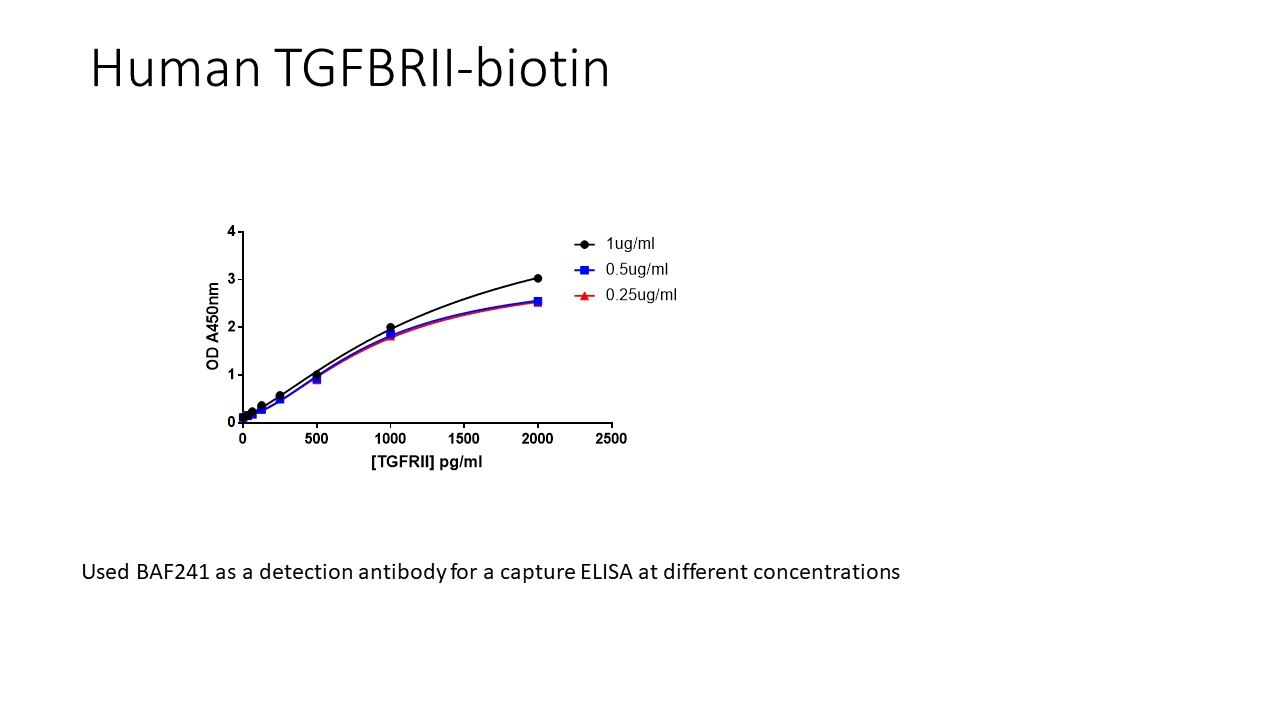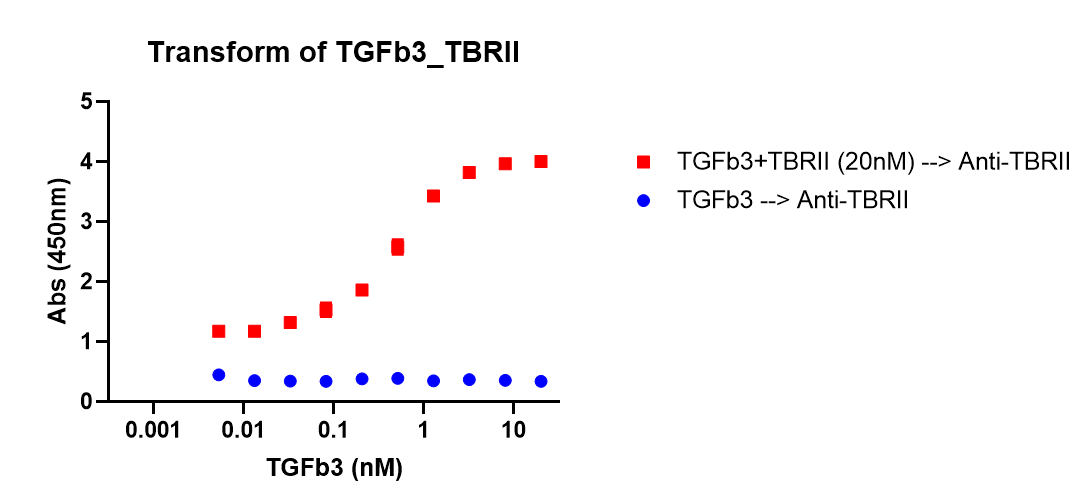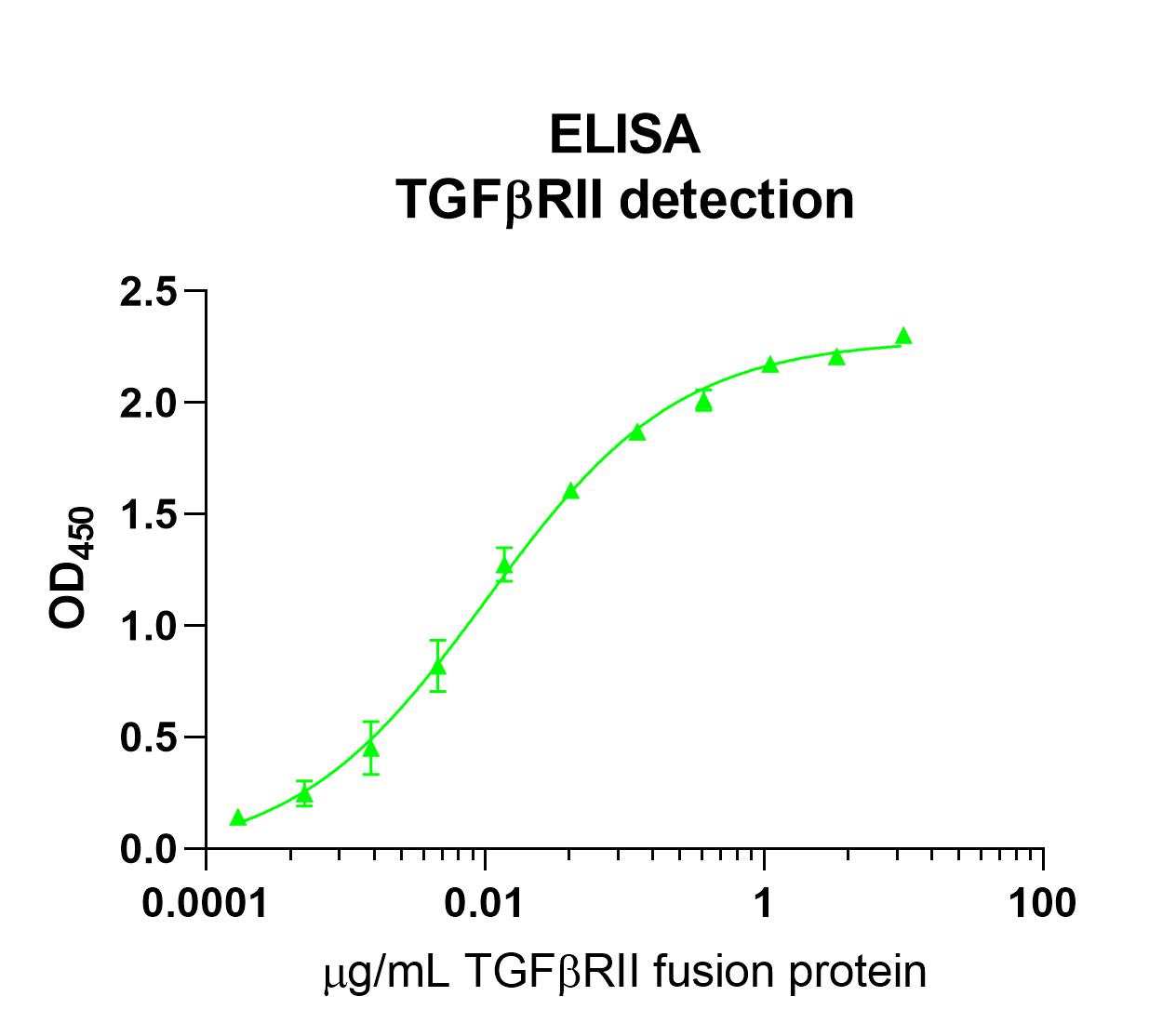Human TGF-beta RII Biotinylated Antibody Summary
Ile24-Asp159
Accession # P37173
Applications
Human TGF-beta RII Sandwich Immunoassay
Please Note: Optimal dilutions should be determined by each laboratory for each application. General Protocols are available in the Technical Information section on our website.
Reconstitution Calculator
Preparation and Storage
- 12 months from date of receipt, -20 to -70 °C as supplied.
- 1 month, 2 to 8 °C under sterile conditions after reconstitution.
- 6 months, -20 to -70 °C under sterile conditions after reconstitution.
Background: TGF-beta RII
Most cell types express three sizes of receptors for TGF-beta. These are designated type I (53 kDa), type II (70 - 85 kDa), and type III (250 - 350 kDa). The type III receptor, a proteoglycan that exists in membrane-bound and soluble forms, binds TGF-beta 1, TGF-beta 2, and TGF-beta 3 but does not appear to be involved in signal transduction. The type II receptor is a membrane-bound serine/threonine kinase that binds TGF-beta 1 and TGF-beta 3 with high affinity and TGF-beta 2 with a much lower affinity. The type I receptor is also a membrane-bound serine/threonine kinase that apparently requires the presence of the type II receptor to bind TGF-beta. Current evidence suggests that signal transduction requires the cytoplasmic domains of both the type I and type II receptors.
The recombinant soluble TGF-beta type II receptor is capable of binding TGF-beta 1, TGF-beta 3, and TGF-beta 5 with sufficient affinity to act as an inhibitor of these isoforms at high concentrations. The soluble receptor also binds TGF-beta 2, but with an affinity at least two orders of magnitude lower. Binding of TGF-beta 1, TGF-beta 3, and TGF-beta 5 to the soluble TGF-beta type II receptor can also be demonstrated by using the soluble receptor as a capture agent on ELISA plates and this observation has been used as the basis for the development of immunoassays for these isoforms of TGF-beta.
Product Datasheets
Citations for Human TGF-beta RII Biotinylated Antibody
R&D Systems personnel manually curate a database that contains references using R&D Systems products. The data collected includes not only links to publications in PubMed, but also provides information about sample types, species, and experimental conditions.
2
Citations: Showing 1 - 2
Filter your results:
Filter by:
-
Ad5/48 hexon oncolytic virus expressing sTGFbetaRIIFc produces reduced hepatic and systemic toxicities and inhibits prostate cancer bone metastases.
Authors: Xu W, Zhang Z, Yang Y, Hu Z, Wang C, Morgan M, Wu Y, Hutten R, Xiao X, Stock S, Guise T, Prabhakar B, Brendler C, Seth P
Mol Ther, 2014-05-05;22(8):1504-17.
Species: Human
Sample Types: Cell Culture Supernates
Applications: ELISA Development (Detection) -
Ig-reactive CD4+CD25+ T cells from tolerized (New Zealand Black x New Zealand White)F1 mice suppress in vitro production of antibodies to DNA.
Authors: La Cava A, Ebling FM, Hahn BH
J. Immunol., 2004-09-01;173(5):3542-8.
Species: Mouse
Sample Types: Whole Cells
Applications: Flow Cytometry
FAQs
No product specific FAQs exist for this product, however you may
View all Antibody FAQsReviews for Human TGF-beta RII Biotinylated Antibody
Average Rating: 4.8 (Based on 4 Reviews)
Have you used Human TGF-beta RII Biotinylated Antibody?
Submit a review and receive an Amazon gift card.
$25/€18/£15/$25CAN/¥75 Yuan/¥2500 Yen for a review with an image
$10/€7/£6/$10 CAD/¥70 Yuan/¥1110 Yen for a review without an image
Filter by:
Immobilized different doses of TGFb3, washed, and incubated with TBRII (20nM). Detect TBRII interaction, w/ Anti-TBRII-biotin followed by strepavidin-HRP.







